Navigation
Remediation of the environmental Impacts of the Akosombo and Kpong Dams in Ghana
The Ghana Hydropower Project has been described as the largest and most ambitious single project implemented since Ghana’s independence in 1957. The project was conceived as a symbol of sound economic progress in the newly independent country. It was intended as multi-purpose project because in addition to the generation of electric power for industry and for urban and rural household energy needs, it was to provide opportunities for large-scale irrigation, modernisation of agriculture, promotion of factories and industries, and the establishment of tourist facilities.
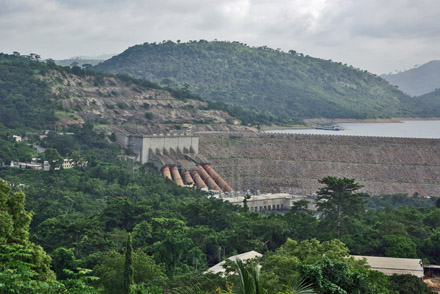 |
| Akosombo Dam Hydroelectric Plant. Photograph taken in late July 2007. Photograph author Allison Stillwell from Wikipedia |
Location:
Volta Basin, Ghana
Problem Overview:
The Akosombo Dam on the Volta River was built in 1963 to enhance and accelerate economic growth of the newly independent state, Ghana. The following benefits were to be generated, among others, from the construction of the dam.
- Massive output of hydroelectric power;
- Enhanced fishing and water transportation upstream; and,
- Improved opportunities for irrigated farming, especially in the lower reaches, and their attendant multiplier economic effects.
Few years after the construction of the major dam, a rapid expansion of industrialisation took place, particularly in the major cities such as the Accra-Tema Metropolitan area, Kumasi, Sekondi-Takoradi and Akosombo. This, in turn, brought about an increased demand for more electric power. By 1981, this new demand necessitated the construction of another dam, a smaller dam at Kpong downstream of the Akosombo Dam. The combined power output of the two dams has since sustained the nation's domestic and industrial power needs.
 |
| Volta Lake, Ghana, taken in April 1993. Photograph by NASA from Wikipedia |
The impoundment of the river at the two sites, at Akosombo and Kpong, caused an alteration of the existing ecological and biophysical processes in the river basin such as:
- A slowing of the flow of the river, both upstream and downstream.
- Flooding of cultivated fields, upstream.
Changes in natural processes, such as a reduction in the flow of the river, resulted in an invasion of aquatic weeds, creation of conditions promoting the density of aquatic snails, silting and closure of the estuary, as well as other more subtle effects.
An invasion of the river's main course by aquatic life led to a corresponding reduction of navigable space both upstream and downstream. This also resulted in a reduction of the harvest resulting in annual production far below the existing demand.
 |
| Manual weed removal using canoes |
The combined effects of the reduced flow rate of the main stream and colonization of aquatic weeds have led to increased numbers of snails,particularly those serving as intermediate hosts of various schistosomiases, the most important being Bulinus truncatus rohfsi (for Schistosoma haematobium) and Biomphalaria pfeifferi (for S. mansoni). The construction of the two dams on the Volta River accelerated the proliferation of these snails in the lake area, on the head pond and in the Lower Volta. Prevalence rates of both urinary and intestinal bilharzias rose significantly and ranged between 70% and 75% in some lakeside communities. In some cases, rates of almost 100% have been recorded among school children. The situation has not been very different in the lower Volta where disease prevalence, especially the intestinal type, has been on the increase. In some riparian communities for example, within a brief period of only four years (1989-1993), prevalence of intestinal schistosomiasis rose from 6% to 53.3%.
Another problem associated with the colonization of weeds in the main stream of the Lower Volta Basin, or downstream, was the reduction in shrimp populations that served as a source of proteins for the riparian communities and which supported the rural fishing industry and economy. Crop yield also declined substantially. Creek agriculture diminished because there natural flooding no longer left rich alluvial deposits that improved soil fertility in the overlying upland areas. Food production fell due to reduced crop-yields from the upland farms. The worst hit economic activities in the downstream communities are:
- River fishing,
- Creek fishing and,
- Clam picking (an activity predominantly controlled by women).
The loss of income as a result of the collapse of the rural economies brought about very intense poverty among the inhabitants of these communities and triggered the following events in the riparian communities spanning both banks of the downstream area.
- Breakdown of cultural and social values leading to prostitution and an increased crime rate in the affected communities.
- Increase in prevalence of sexually transmitted diseases to the extent of becoming a common phenomenon in these communities.
- Widespread migration of the populations, particularly of the young and energetic men and women.
Between 1962-63 alone, 20,000 people fled from the communities in the downstream area to Accra and nearby towns. Towns and communities such as Akuse, Amedeka, Volivo, Adidome are now mostly communities of old men and women who live in deplorable conditions.
Background:
The Ghana Hydropower Project has been described as the largest and most ambitious single project implemented since Ghana’s independence in 1957. The project was conceived as a symbol of sound economic progress in the newly independent country. It was intended as multi-purpose project because in addition to the generation of electric power for industry and for urban and rural household energy needs, it was to provide opportunities for large-scale irrigation, modernisation of agriculture, promotion of factories and industries, and the establishment of tourist facilities.
The Preparatory Commission (1952 – 1956), under Commander R. G. A. Jackson took into account the economic, financial, and technical feasibility of the project along with the socio-cultural and public health implications. These concerns were for the areas behind the proposed dam, the on-site dam area, and the area below the dam. The Commission recommended a comprehensive environmental and feasibility study to ensure an integrated programme for the best interest of the people, the environment and the economy. Based on subsequent events, it appears that the need at that time for the country to have a cheap source of electricity did have overriding priority over other considerations.
The Volta River Authority (VRA), established in 1961, was assigned the responsibility of seeing to the construction of the dam at Akosombo and the eventual generation of electric power and to plan, organise and implement a resettlement programme.
The construction of the dam (1961-64) on the Volta river led to the formation of the new Volta Lake with a Reservior area of about 3275 square miles (8500km2), 3.6% of Ghana’s total land area, and a shoreline exceeding 3000 miles (4800km). This, in turn, changed or modified the existing physical, biological and socio-economic environment of the people above and below the Akosombo dam and created conditions for which explosive outbreaks of water-borne diseases such as urinary schistosomiasis (also known as bilharziasis) were found to be very high. The problem of human resettlement created one of the earliest and by far the most serious impacts of the Volta River Project which the Authority had to face. The problems encountered in the Volta basin, particularly of human health, resettlement and the environment were enormous. Several reasons have been given for this state of affairs, including inadequate time scheduled for planning and implementation, shortage of administrative capacity, insufficient political will and finance, absence of meaningful local involvement and commitment prior to its development.
From the scientific point of view, however, the most important contributory factors were:
- Failure to implement fully the recommendations of the preparatory commission;
- Failure to recognise the importance of a multi-disciplinary approach to solving the problems. This would have helped to avoid a split into two camps: engineering and social. It became quite evident that the non-engineering aspects of the project did not receive the necessary full attention.
The public health related problems were those of a switch between two disease episodes – i.e. the one that thrives well in (lotic) riverine system and the other which thrives well in (benthic) riverine systems. It was a switch between onchocerciasis (river blindness) and urinary schistosomiasis. Onchocerciasis is transmitted by the black-fly (Simuluim damnosum) which breeds solely in fast flowing waters. Urinary schistosomiasis, commonly called bilharziasis, is a chronic snail-borne infection, which frequently occurs in water development schemes in tropical countries. The disease was endemic in Ghana long before the creation of the Volta Lake; but endemicity was low along the Volta River. Prevalence in school children was 5% according to an epidemiological survey made in 1960-61 before the lake was formed.
The creation of the lake and the consequent biological explosion of aquatic weeds associated with the aquatic snail, the “intermediate host,” together with mass migration into the fishing communities above the head pond area from regions in which the disease was endemic led to a great increase in the prevalence of the disease in many localities around the lake.
Transmission occurs in the lake itself. Exposure to infection is especially intense for fishermen who dive to set fish traps as well as for people, particularly children, who draw water from the lake or bathe there. Surveys in 1964-77, after the construction of the dam, showed a 90% prevalence rate in school children with a ratio of two boys to one girl. It has thus far proven difficult to control the snail intermediate hosts by eliminating the aquatic weeds. The problem of bilharzias in the lake basin is therefore seen as a disease, which embraces the lake and the entire Volta Delta.
The migratory habits of the fishermen ensured the spread of the disease from endemic areas to other areas.
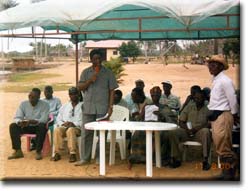 |
| A discussion between research scientists and a section of chiefs in the project communities. |
This is because when fishermen move from place to place they also infect previously uninfected water bodies, which become a source of infection in the new community.
The Volta Basin Research Project (VBRP); a multidisciplinary research organisation, was set up by the University of Ghana in 1963 with a mission of maximising the benefits and mitigation or minimising the negative effects on the environment, of the impoundment of the Volta River at Akosombo.
Implementation Status:
The implementation process involved various components with entirely different methodologies and reflects the multi-faceted nature of the impacts of the dam on the environment. Most or practically all the activities meant to address the problems are ongoing.
The methods employed to address the public health problems include: the use of chemotherapy (a drug called PRAZIQUANTEL); biological control methods to disrupt the life-cycle in the primary host of the disease causing organism, in this case the Schistosoma
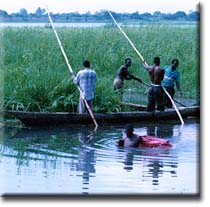 |
sp.; and ecological methods to destroy the habitat of the snail host or primary host. These methods did not have any adverse effects on the environment. Praziquantel was taken orally and so did not have any direct effect on the environment. The detailed description of the various methods employed is shown below. Public education and provision of sanitary facilities were used to maximise avoidance of the risk of infection in the vulnerable group. The major health problem that arose as a result of the creation of the dam was the increased prevalence rate or proliferation of schistosomiasis in communities spanning the newly created lake and in the Lower Basin.
CHEMOTHERAPY
The first step in the implementation was the use of chemotherapy, administration of drugs for treating infected members of the communities. The drug or medicine used was praziquantel tablets (Biltricide), which effectively reduces the worm and egg load borne by infected people. This was used for reducing damage done by the schistosome parasite in human hosts and to reduce infection of previously non-infested water bodies. The most vulnerable groups were fishermen and school children. These intensely affected people were treated when the project was implemented.
BIOLOGICAL & ECOLOGICAL CONTROL
The biological and ecological control methods for weeds as well as snail reduction involve manual and mechanical clearing of aquatic weeds. Snails, which crawl over weeds for support and nourishment, are eliminated when the weeds are cleared, thus reducing the density of the snail.
The fishermen in the communities around and within the lake and head pond areas and the Lower Volta Basin were organised into cooperative groups in what was termed the “Let’s Bring Back Our Fish Stock” Project. Chiefs and youth leaders in the fishing communities were entrusted with the responsibility of organising the local people to participate in this project of weed control. This method was moderately successful and contributed to some improvement in the river flow rate.
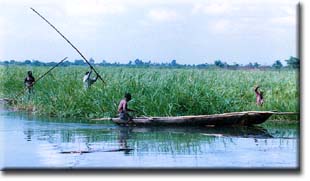 |
The major constraint associated with this method was the reluctance of members of the community to get involved if no payments were forthcoming. This attitude eventually led to the collapse of the cooperative groupings.
One other successful method employed was to open the river outlet into the sea at the estuary, which was hitherto closed by spits and sandbars. This allowed intrusion of salty seawater several kilometres upstream causing the death of the snails which could not survive in the saline conditions. This method was found to have killed snail hosts some 30km upstream, thereby, reducing the prevalence rates of schistosomiasis (bilharzia) by about some 70%. (Dzidzo, 1997; Ansah and Tetteh-Mensah, 1999).
Health Education
Health education was a major component of the implementation process. The riparian and lakeside communities were constantly educated on the transmission and pathology of the disease. (This study was carried out by the health team from VBRP & VRA) They were also educated on control measures. Health education was to help the communities change the social and cultural habits which encouraged transmission of the infection. Because schoolchildren constituted one of the most vulnerable groups, songs on control measures, mode of transmission and on habits that render school children vulnerable to the attack of the schistosome parasite were composed and taught in the schools in the lakeside and riparian communities. The songs were composed by and the program organised by Dr. J. E K Kpikpi, the head of public health research team from VBRP.
These songs were translated into local languages (Dangme & Ewe) and taught to fishermen and school children. This method yielded very successful results: a considerable reduction in the prevalence of bilharzia among school children.
Although re-infection occurred in certain communities, risk was much less than before the effort began. Prevalence declined by about 70-80% and in some communities, the decline approached 90% (Ansah and Tetteh-Mensah, 1999).
IMPLEMENTATION OF INCOME-GENERATING PROJECTS
The socio-economic problems that arose from the creation of artificial lakes behind the Akosombo and the Kpong dams on the Volta River have been disturbing because of their social and political ramifications.
As a result of strong protest from chiefs and opinion leaders of the affected communities, the Volta River Authority (VRA) came under intense pressure to institute remedial measures to mitigate the economic hardships brought to bear on them. As a remedial measure, the VBRP with support from (VRA) implemented some of income-generating projects that sought to provide employment opportunities for the inhabitants of the affected areas.
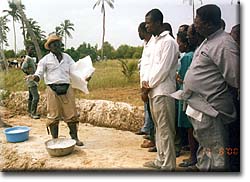 |
| A scientific officer demonstrating a management principle of shrimp farming to community members in the project area. |
Artificial shrimp farms were established in the Lower Volta communities using very simple and inexpensive methods. The methods, however, were somewhat labour-intensive at the initial stages. When it fully took-off, it was less labour demanding. The farming method was such that the local people could easily learn and practise to generate incomes. The shrimp farming empowered the local people economically by providing them with employment opportunities and sources of income.
Revival of the rural industries and local cultures and the return of the migrant populations to their places of residence are a reflection of the success of the project.
SHRIMP FARMING METHODOLOGY
Shrimp stocking ponds were dug along a gradient on the banks of the river. For big shrimp farms, up to 10 such ponds were dug in series and connected to each other by a channel. The main channel connecting the various shrimp ponds opens up at an angle of 450 to the longitudinal axis of the mainstream of the river. The shrimp ponds were also dug along the long axis of the main stream and at a gradient downstream so that water from the river could flow along the main channel by gravity and back into the river at a point downstream. The reliance on gravity ensured that no energy was required to supply water to the shrimp ponds, which also connected with the main waterway or water canal through short water canals, also at a gradient downstream.
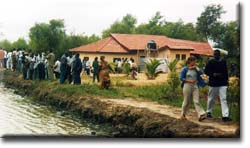 |
| A tour along the stream whose main stream had been rid of aquatic weeds manually. The building in the background is a residential facility that houses shrimp farm workers. |
They ran perpendicular to the main waterway. The point of connection between the short canals and the main water channel could be closed and opened at will. It was closed when the shrimp ponds were filled with water and opened when draining was required. This provision allowed for minimisation or elimination of predation. Since there was no extraneous matter other then the river water from the main stream, pollution of the river was eliminated. The six fish ponds provided employment for 100 people and an overhead profit of C120M (the equivalent of about US$6,000) to the management.
The shrimp ponds were stocked with juvenile shrimp supplied to the local shrimp farmers at no cost by the Volta River Authority (VRA) and the Ministry of Food and Agriculture (MOFA).
The financial capital to establish the farms by the local people was not a major constraint. What they needed to supply was labour to dig the ponds.
Problems and Constraints:
The most serious constraint of the remediation project has been the general apathy of the local people towards a progressive attitudinal and behavioural change. The low levels of education of the local people has also been a serious limitation to the success and sustained momentum of the project. The lack of will on the part of the local people to change their behaviour and attitudes provided an impetus for high rates of re-infection of schistosomasis (bilharzias) in some communities, particularly among school children. In Ada-Foh, the follow-up studies after 14 months indicated that re-infection rate was 6%. This was attributed to the reluctance of the school children in this town to change their habits. Also, about 35% of the head pond area is still infested with aquatic weeds. This is largely due to the high re-infestation rate (6-8 weeks after clearing) of the aquatic weeds. The high rate of re-infestation is promoted by several factors, the most significant ones being:
- The presence of seeding material in the ponds and creeks originally in the area earmarked for inundation in the form of seeds, shoots, offsets, turions, rhizomes etc;
- The shallowness of the head pond (mash-depth 18m) allowing for sunlight penetration and good aeration, which promote plant growth;
- Import of nutrients from the sewage system from the nearby Akosombo cattle dung on the East Bank, fertilizer import from nearby rice farms, and nutrients from the inundated area itself (1/6th of this area was under intensive commercial agriculture); and;
- The presence of relatively large number of sheltered coves and physical barriers, which provided undisturbed conditions required for weed growth and development.
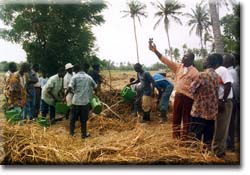 |
| An afforestation activity, agroecology components of the Lower Volta Environmental Impact Studies (LVEIS). |
The low level of education of the inhabitants of the local communities made it difficult for them to appreciate the technicalities involved in the methods used in shrimp farming. Therefore the local people could not sustain the growth, expansion and development of the shrimp farms due to lack of management skills. This project was a partial success. It did bring about considerable improvement in the quality of life of the local people and re-populated the communities. It could not be counted as a complete success because, when left on their own, the local people could not sustain the various project components.
Follow-up:
Follow-up studies were made by administrative checking, questionnaires, and urinalysis to determine re-infection rates in the in the school children for the health intervention component. Also questionnaires were administered to the inhabitants of the study sample with questions covering some socio-economic variables such as income levels and employment status, among other things, to establish the level of success of the intervention. Practically all the phases of the project are on going.
News Update:
On March 6, 2008, staff members at the VBRP Secretariat reported that schistosomiasis has now been largely eliminated in the Lower Volta Basin as result of health promotion and chemotherapeutic activities undertaken by the Volta Basin Research Project.
Documentation:
Diaw, K. & Schmid, E. (1990) Effects of Volta Resettlement in Ghana-A Re-appraisal after 25 years. Hamburg.
Gordon, C. & Amatekpor, J. K. (1999) The Sustainable Integrated Development of the Volta Basin in Ghana, Volta Basin Research Project, Accra, 159p.
Kalitsi, E. A. K. (1996) Organization of Resettlement in Volta Resettlement Experience op. cit.
UNDP/FAO Rome, (1979) Volta Lake Research & Development Project in Ghana: Project Findings & Recommendations.
VRA: Kpong Hydroelectric Project-Resettlement Programme, P.I
Submitted by:
Julius Najah Fobil C/o Faculty of Science
P. O. Box 71
University of Ghana
Legon, Accra
Ghana.
jfobil@ug.edu.gh or jn_fobil@hotmail.com
Volta Basin Research Project (VBRP).
P. O. Box LG 209.
University of Ghana
Legon, Accra
Dr. Daniel K. Attuquayefio, PhD
Associate Professor and Head of the Environmental Science Programme
University of Ghana
Tel:++233-21-500467
Information Date: 2008-03-26
Information Source: Volta Basin Research Project (VBRP), University of Ghana
- Login to post comments

Search
Latest articles
Agriculture
- World Water Week: Healthy ecosystems essential to human health: from coronavirus to malnutrition Online session Wednesday 24 August 17:00-18:20
- World Water Week: Healthy ecosystems essential to human health: from coronavirus to malnutrition Online session Wednesday 24 August 17:00-18:20
Air Pollution
- "Water and Sanitation-Related Diseases and the Changing Environment: Challenges, Interventions, and Preventive Measures" Volume 2 Is Now Available
- Global Innovation Exchange Co-Created by Horizon International, USAID, Bill and Melinda Gates Foundation and Others
Biodiversity
- It is time for international mobilization against climate change
- World Water Week: Healthy ecosystems essential to human health: from coronavirus to malnutrition Online session Wednesday 24 August 17:00-18:20
Desertification
- World Water Week: Healthy ecosystems essential to human health: from coronavirus to malnutrition Online session Wednesday 24 August 17:00-18:20
- UN Food Systems Summit Receives Over 1,200 Ideas to Help Meet Sustainable Development Goals
Endangered Species
- Mangrove Action Project Collaborates to Restore and Preserve Mangrove Ecosystems
- Coral Research in Palau offers a “Glimmer of Hope”
Energy
- Global Innovation Exchange Co-Created by Horizon International, USAID, Bill and Melinda Gates Foundation and Others
- Wildlife Preservation in Southeast Nova Scotia
Exhibits
- Global Innovation Exchange Co-Created by Horizon International, USAID, Bill and Melinda Gates Foundation and Others
- Coral Reefs
Forests
- NASA Satellites Reveal Major Shifts in Global Freshwater Updated June 2020
- Global Innovation Exchange Co-Created by Horizon International, USAID, Bill and Melinda Gates Foundation and Others
Global Climate Change
- It is time for international mobilization against climate change
- It is time for international mobilization against climate change
Global Health
- World Water Week: Healthy ecosystems essential to human health: from coronavirus to malnutrition Online session Wednesday 24 August 17:00-18:20
- More than 400 schoolgirls, family and teachers rescued from Afghanistan by small coalition
Industry
- "Water and Sanitation-Related Diseases and the Changing Environment: Challenges, Interventions, and Preventive Measures" Volume 2 Is Now Available
- Global Innovation Exchange Co-Created by Horizon International, USAID, Bill and Melinda Gates Foundation and Others
Natural Disaster Relief
- STOP ATTACKS ON HEALTH CARE IN UKRAINE
- Global Innovation Exchange Co-Created by Horizon International, USAID, Bill and Melinda Gates Foundation and Others
News and Special Reports
- World Water Week: Healthy ecosystems essential to human health: from coronavirus to malnutrition Online session Wednesday 24 August 17:00-18:20
- STOP ATTACKS ON HEALTH CARE IN UKRAINE
Oceans, Coral Reefs
- World Water Week: Healthy ecosystems essential to human health: from coronavirus to malnutrition Online session Wednesday 24 August 17:00-18:20
- Mangrove Action Project Collaborates to Restore and Preserve Mangrove Ecosystems
Pollution
- Zakaria Ouedraogo of Burkina Faso Produces Film “Nzoue Fiyen: Water Not Drinkable”
- "Water and Sanitation-Related Diseases and the Changing Environment: Challenges, Interventions, and Preventive Measures" Volume 2 Is Now Available
Population
- "Water and Sanitation-Related Diseases and the Changing Environment: Challenges, Interventions, and Preventive Measures" Volume 2 Is Now Available
- "Water and Sanitation-Related Diseases and the Changing Environment: Challenges, Interventions, and Preventive Measures" Volume 2 Is Now Available
Public Health
- Honouring the visionary behind India’s sanitation revolution
- Honouring the visionary behind India’s sanitation revolution
Rivers
- World Water Week: Healthy ecosystems essential to human health: from coronavirus to malnutrition Online session Wednesday 24 August 17:00-18:20
- Mangrove Action Project Collaborates to Restore and Preserve Mangrove Ecosystems
Sanitation
- Honouring the visionary behind India’s sanitation revolution
- Honouring the visionary behind India’s sanitation revolution
Toxic Chemicals
- "Water and Sanitation-Related Diseases and the Changing Environment: Challenges, Interventions, and Preventive Measures" Volume 2 Is Now Available
- Actions to Prevent Polluted Drinking Water in the United States
Transportation
- "Water and Sanitation-Related Diseases and the Changing Environment: Challenges, Interventions, and Preventive Measures" Volume 2 Is Now Available
- Urbanization Provides Opportunities for Transition to a Green Economy, Says New Report
Waste Management
- Honouring the visionary behind India’s sanitation revolution
- Honouring the visionary behind India’s sanitation revolution
Water
- Honouring the visionary behind India’s sanitation revolution
- Honouring the visionary behind India’s sanitation revolution
Water and Sanitation
- Honouring the visionary behind India’s sanitation revolution
- Honouring the visionary behind India’s sanitation revolution

